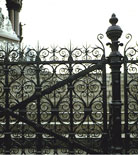|
||||||||||||||||||||||||||||||||||||||

:: The Culture of the Fence: Artifacts and Meanings << Page 1 <<
Page 2 << Page 3 >> Fences were used as a weapon in the population of the Wild West. In the 1880s a war of fences flared as settlers arrived in the 11 western stated only to find out that rangers were fencing off huge pasture terrains they could not buy. This conflict coincided with the boom of barbed wire, invented in 1873 and thriving as a cheap and efficient tool for enclosure. Connotatively, barbed wire made an aggressive statement. Displaying constantly a message of physical injury, it made the idea of violence habitual – perhaps more acceptable - in the culture. Indeed, settlers who disregarded the barbed-wire notification of rangers soon saw their crops burnt and their homes devastated, thus physically experiencing the message In today’s legal state fences separate various social units in space or channel human traffic in the form of railings. Going in and out of fences we constantly group and re-group thus forming the very dynamic of society. Fences regulate our movement on the ground we inhabit and their regular patterns symbolize that. But behind all these practices a powerful myth emerges underpinning the use of fences: the need for orderly separation between humans implying control. Our constructed need of fences can be clearly seen in the instance of New York’s public parks, which are thoroughly fenced and locked up at night. It seems that the parks are protected from someone while in fact, they are public places supposed to be at the disposal of all citizens. Obviously, “the public” is not the egalitarian mass that the democratic ideology makes it seem. It is split into dominant and subordinate groups. If one part of the public, presumably the majority, wishes to enjoy safe and unpolluted parks, it has to bar off another part of the public, say the homeless minority, which is likely to interfere with the project. The local government being responsible for “the public interest”, goes with the majority. Thus, fences serve for the exclusion of social minorities and contribute to the process of reducing the notion of "public" to the dominant social group. Fences are a product of the struggle for control between humans. In any situation they ensure that someone has the upper hand. That is why they are associated with law, property, conquest, protection, separation, social division, order and regulation – all of these - ideas ensuing from the practice of dispute. Fences are a technology we have conceived as a solution to the issue of social conflict. They are a symbolic expression of our deeply nourished conviction that we should have some form of social control. People started employing fences to indicate control over land. But at the same time, the constant employment of fences has induced people to focus on issues of control making these an important part of the social reality. The fact that the symbols of control were substantial constituents of our immediate physical environment helped naturalize the idea of control representing it as an integral part of the world we inhabit. While from a Barthian perspective, the myth of the need for social control could be said to underpin the use of fences, from a McLuhanesque perspective the constant employment of fences has fed this myth as a way of thinking. However, the two statements are tautological – because ultimately culture perpetuates itself through symbolic usage of practices. Fences have been the physical reminder of an idea which, while a social construction, has turned into an omnipresent reality. At this point the history of the fence as artifacts-usage and the history of the fence as a series of meanings merge. It seems that with sentient beings, media always trigger symbolic interpretation – which is why they create cultures. References Barthes, R. [1957] (1972). Mythologies. New York: Hill and Wang.Caesar, J. ([52 BC] 1996). Seven Commentaries on Gallic War with an Eighth. Commentary by Aulus Hirtius. Oxford: Oxford University Press. Clawson, M. (1951). Uncle Sam's Acres. New York: Dodd, Mead & Co.. Coulanges, F. de (1927).The Origin of Property in Land. Edinburgh: Riverside. Dreicer, G. (1996). Between Fences. New York: Princeton Architectural Press. Griswold, A. (1948). Farming and Democracy. New York: Harcourt, Brace. Innis, H. (1951). The Biases of Communication. Toronto: University of Toronto Press. Langer, S. (1951). Philosophy in a New Key. Cambridge: Harvard University Press. Liversage, V. (1945) Land Tenure in the Colonies. Cambridge: Cambridge University Press. McLuhan M.[1964] (2001). Understanding media: the extensions of man. Cambridge, Mass.: MIT Press. Peffer, E. (1951). The Closing of the Public Domain: Disposal and Reservation Policies 1900-1950. Stanford, CA: Stanford University Press. Pollard, E., Hooper, M.D. & Moore, N.M. (1974) Hedges. London: Collins. Postman, N. & Weingartner, C. (1969). “Meaning making.” In Teaching as a Subversive Activity. New York: Dell, pp. 82-132. Rousseau, J.-J. ([1762] 1994). Discourse on Political Economy; and The Social Contract. Oxford: University Press. Southworth, S. and M. (1992). Ornamental Ironwork. New York: McGraw-Hill. Tacitus, C. ([98 AD] 1999). Germania. Warminster, England: Aris & Phillips. Young, A. ([1792] 1929). Travels in France during the Years 1787, 1788 & 1789. Cambridge, England: University Press. |
||||||||||||||||||||||||||||||||||||||
|
:: I. M. Pei's La Pyramide du Louvre: A Diamond in
the Rough or Merely Junkspace? By Rebecca L. Moyer :: The Culture of the Fence: Artifacts and Meanings By Christina Kotchemidova :: On the Significance of Death in Culture & Communication Research By Charlton McIlwain, Ph.D. | ||||||||||||||||||||||||||||||||||||||
|
:: Swept Away By An Unusual Destiny In The Blue Sea Of August: Lina Wertmüller, 1974 - Guy Ritchie's Swept Away 2001 By Laura Meucci :: What Do I Get? Punk Rock, Authenticity, and Cultural Capital By Brian Cogan The Osbournes': Genre, Reality TV, and the Domestication of Rock 'n Roll By Rick Pieto and Kelly Otter |
||||||||||||||||||||||||||||||||||||||
| ::
About Contributors |
||||||||||||||||||||||||||||||||||||||
|
||||||||||||||||||||||||||||||||||||||
| About :: Archive :: Staff :: Submit :: Contact | ||||||||||||||||||||||||||||||||||||||









